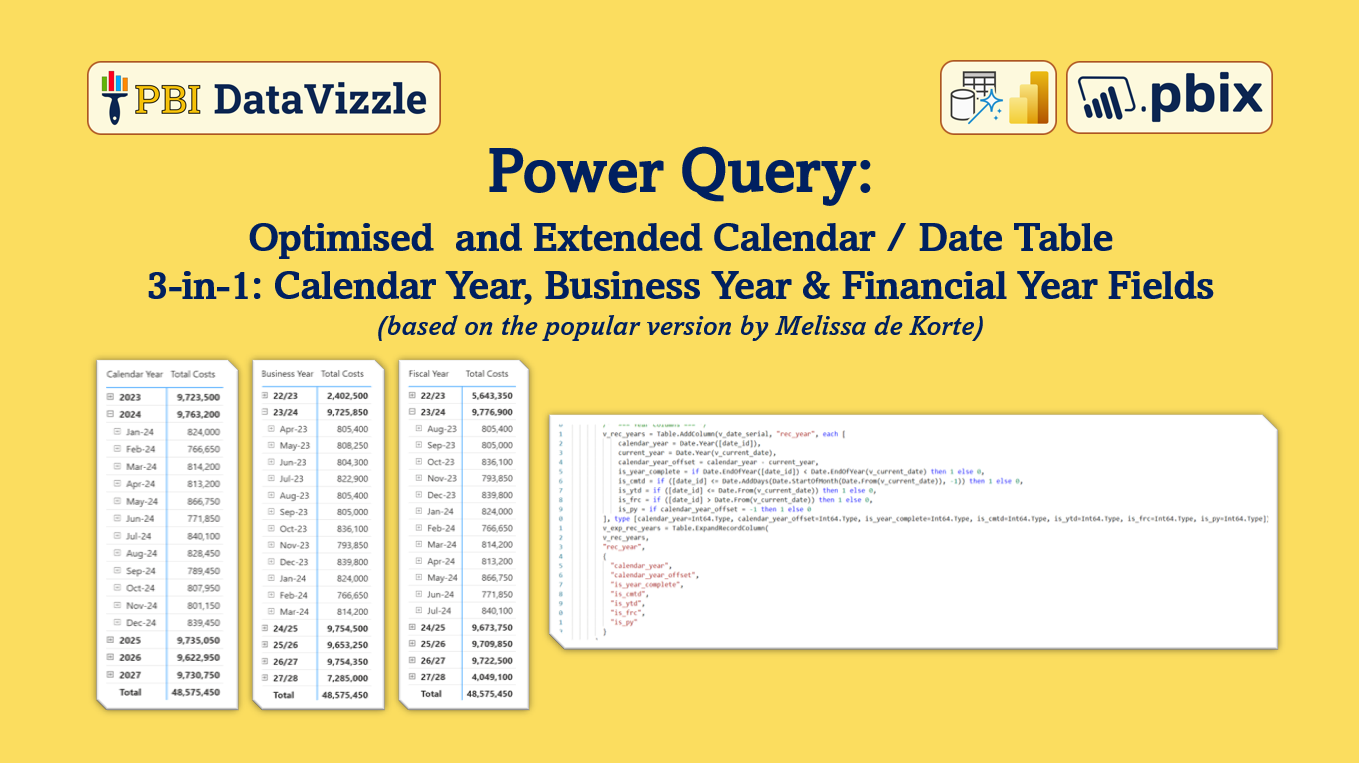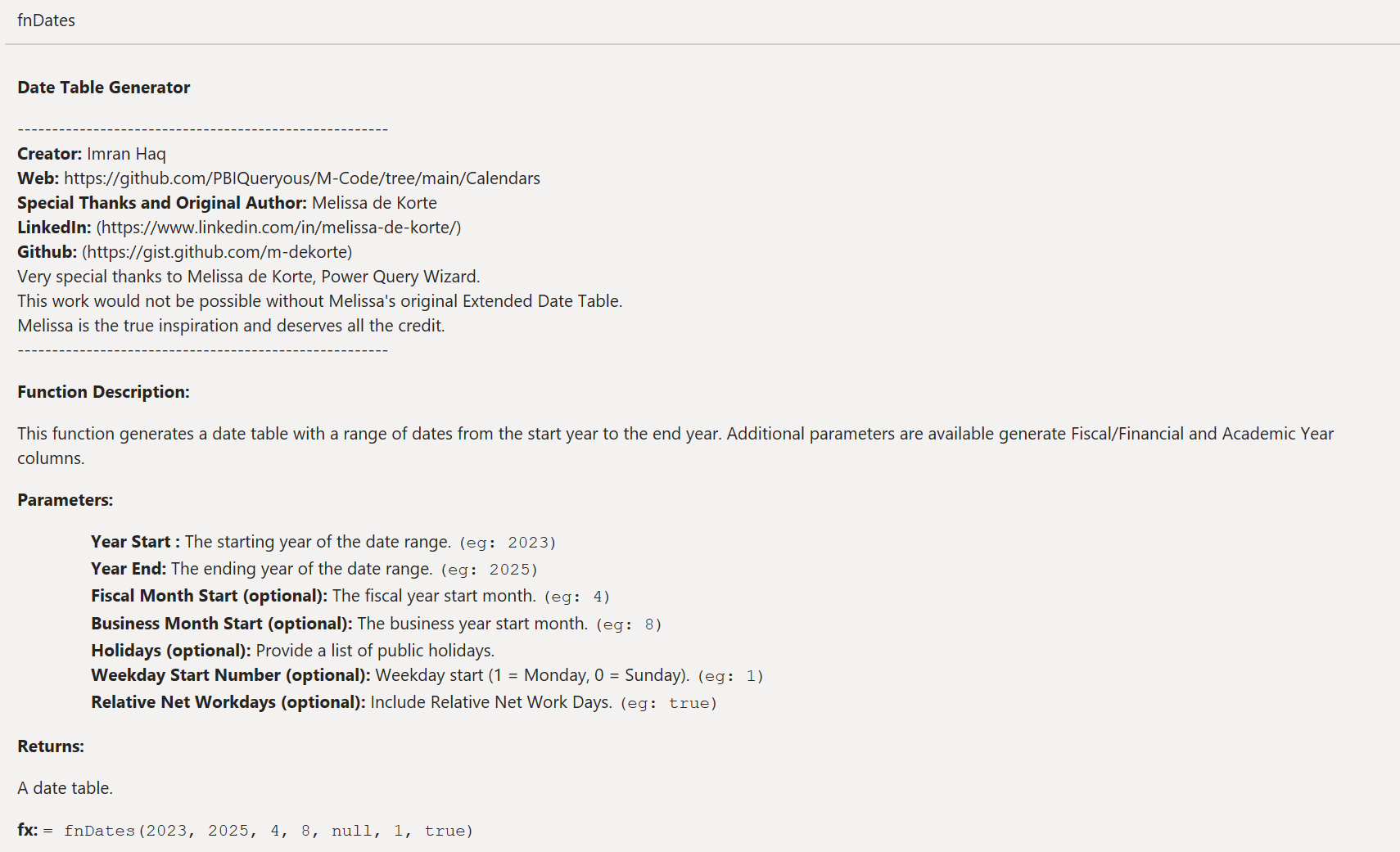Power Query - Optimised Calendar/Dates Table
Enjoy a newly refurbished calendar table dimension with business calendar and fiscal calendar date fields 🕊️🧙🏼♂️✨
💌
PBIXfile available at the end of the article 1 Enjoy!
Intro
The calendar / dates table is easily THE most important dimension table in any semantic model. Most of you will have came across Melissa de Korte’s famous Extended Date Table no doubt. My date table builds upon Melissa’s great work even further additional fields and a dynamic 3-in-1 dates table:
- Calendar Year
- Business Year
- Financial Year
Column selection is dynamic, so Business & Financial Year fields are only selected if Business / Fiscal Start Month is input in the function parameters.
. . .
Build
You can begin debugging the code directly the PBIX1 linked in the footnotes. In the next section, we’ll take a look at some important code snippets.
. . .
Code
In this Code segment, we will look some (but not all) of the most important transformations and useful patterns used to calculate the requisite calendar and fiscal year fields. We will use a combination of M-code and pseudo-code so we can better understand some of the underlying mechanics behind the calendar table values:
Calendar Table Transformation Steps
Parameters
1
2
3
4
p_start_date = #date(p_year_start,01,01) // #date( 2024 , 01 , 01 )
p_end_date = #date(p_year_end,12,31) // #date( 2027 , 12, 31 )
v_day_count = Duration.Days(Duration.From(p_end_date - p_start_date)) + 1
// Duration.Days ( Duration.From (#date( 2027 , 12, 31 ) - #date( 2024 , 01 , 01 ) )) + 1
Contiguous List of Dates
1
v_source = List.Dates(p_start_date, v_day_count, Duration.From(1))
| List |
|---|
| 01/01/2024 |
| 02/01/2024 |
| 03/01/2024 |
| 04/01/2024 |
| …etc |
| 30/12/2027 |
| 31/12/2027 |
Generate Date Serial Number
We can derive a date serial number which can act as an alternative key.
1
2
3
4
5
6
7
v_date_serial = Table.AddColumn(
v_to_table,
"date_serial_number",
each Duration.Days([date_id] - #date(1900, 1, 1))
, Int64.Type
)
| date_id | date_serial_number |
|---|---|
| 01/01/2024 | 45290 |
| 02/01/2024 | 45291 |
| 03/01/2024 | 45292 |
| 04/01/2024 | 45293 |
| …etc | …etc |
| 30/12/2027 | 46019 |
| 31/12/2027 | 46020 |
Generate Year-specific Columns
The following examples are a brilliant use case for record fields. This is one of the first optimisations where instead of creating 8 separate steps for 8 separate columns, we can create 8 columns in 1 step. Here’s how we do it, note the square brackets on each [...]. Every variable inside the square brackets is a new column:
psuedo-code
1
2
3
4
5
6
7
8
9
10
11
12
13
14
15
16
current_step = Table.AddColumn(
previous_step,
"column_name",
each [
column1 = formula1,
column2 = formula2,
column3 = formula3
],
type [
column1 = Text.Type, // column data type
column2 = Date.Type, // column data type
column3 = Int64.Type // column data type
]
)
real-code
1
2
3
4
5
6
7
8
9
10
11
12
13
14
15
16
17
18
19
20
21
22
23
24
25
26
27
28
29
30
31
32
33
34
35
36
37
38
39
40
v_rec_years = Table.AddColumn(
v_date_serial,
"rec_year",
each [
// get calendar year
calendar_year = Date.Year([date_id]),
// get current year: Date.Year( #date( 2025, 04 , 21 ) )
current_year = Date.Year(v_current_date),
// get current year offset: 2024 - 2025
calendar_year_offset = calendar_year - current_year,
// check if the calendar year is complete
is_year_complete = if Date.EndOfYear([date_id]) < Date.EndOfYear(v_current_date) then 1 else 0,
// check if date is completed month to date (cmtd)
is_cmtd = if ([date_id] <= Date.AddDays(Date.StartOfMonth(Date.From(v_current_date)), - 1)) then 1 else 0,
//check if date is year-to-date (ytd)
is_ytd = if ([date_id] <= Date.From(v_current_date)) then 1 else 0,
// check if date is forecast/future (frc)
is_frc = if ([date_id] > Date.From(v_current_date)) then 1 else 0,
// check if date is in the previous year (py)
is_py = if calendar_year_offset = - 1 then 1 else 0
],
type [
calendar_year = Int64.Type,
calendar_year_offset = Int64.Type,
is_year_complete = Int64.Type,
is_cmtd = Int64.Type,
is_ytd = Int64.Type,
is_frc = Int64.Type,
is_py = Int64.Type
]
)
| date_id | date_serial_number | calendar_year_offset | is_year_complete | is_cmtd | is_ytd |
|---|---|---|---|---|---|
| 29/03/2025 | 45743 | 0 | 0 | 1 | 1 |
| 30/03/2025 | 45744 | 0 | 0 | 1 | 1 |
| 31/03/2025 | 45745 | 0 | 0 | 1 | 1 |
| 01/04/2025 | 45746 | 0 | 0 | 0 | 1 |
| 02/04/2025 | 45747 | 0 | 0 | 0 | 1 |
| 03/04/2025 | 45748 | 0 | 0 | 0 | 1 |
Generate Fiscal Calendar Fields
Next we will demonstrate how we can derive the fiscal year columns. This method can be reused and reapplied to the business column fields. The variable names will become the columns
1
2
3
4
5
6
7
8
9
10
11
12
13
14
15
16
17
18
19
20
21
22
23
24
25
26
27
28
29
30
31
32
33
34
35
36
37
38
39
40
41
42
43
44
45
46
47
48
49
50
51
52
53
54
55
56
57
58
59
60
61
62
63
64
65
66
67
68
69
70
71
72
73
74
75
76
77
78
79
80
81
82
83
84
85
86
87
88
89
90
91
92
93
94
95
96
97
98
99
100
101
102
103
104
105
106
107
108
109
110
111
112
113
114
115
116
117
118
119
120
121
122
123
124
125
126
127
128
129
130
131
132
133
134
135
136
137
138
139
140
141
142
143
144
145
v_rec_fiscal_fields = = Table.AddColumn(
v_exp_rec_business_fields,
"BusinessRecords",
each [
fiscal_year_num = ( // fiscal year number
if [month_num] >= v_fy_start_month
and v_fy_start_month > 1
then [calendar_year] + 1
else [calendar_year]
),
fiscal_year_offset = ( // calendar year minus
if [month_num] >= v_fy_start_month
then ([calendar_year] + 1)
else [calendar_year]
)
- // minus
( // current year
if v_current_month_num >= v_fy_start_month
then (Date.Year(v_current_date) + 1)
else Date.Year(v_current_date)
),
fiscal_year = // eg: 24/25
Text.End(Text.From(fiscal_year_num -1), 2) // Text.End(2024, 2)
& "/" &
Text.End(Text.From(fiscal_year_num ), 2), // Text.End(2025, 2)
// "FY" & Text.End(2025,2) = "FY25"
fiscal_year_short = "FY" & Text.End(Text.From(fiscal_year_num), 2),
// field to enable default "Current Fiscal Year" slicer selection
fiscal_year_selection = if fiscal_year_offset = 0 then "Current Fiscal Year" else fiscal_year,
// flag current fiscal year
is_current_fy = if fiscal_year_offset = 0 then 1 else 0,
// flag previous fiscal year
is_previous_fy = if fiscal_year_offset = -1 then 1 else 0,
// fiscal quarter number = Number.RoundUp( Date.Month ( Date.AddMonths( 8 - (4-1) )) / 3 )
fiscal_quarter_num = Number.RoundUp( Date.Month( Date.AddMonths( [date_id], - (v_fy_start_month -1) )) / 3 ) ,
// fiscal quarter label - eg: "FQ4"
fiscal_quarter = "FQ" & Text.From( fiscal_quarter_num ) ,
// fiscal quarter - eg: "FQ4 FY25"
fiscal_year_quarter = fiscal_quarter & " " & fiscal_year,
// fiscal quarter numbumer - eg: (2024 * 100) + 04 = 202404
fiscal_year_quarter_num = (fiscal_year_num * 100) + fiscal_quarter_num,
// fiscal period number - eg: FY Start April, Fiscal Number = April = 1, May = 2 etc
fiscal_period_num =
if [month_num] >= v_fy_start_month and v_fy_start_month > 1
then [month_num] - (v_fy_start_month - 1)
else if [month_num] >= v_fy_start_month and v_fy_start_month = 1
then [month_num]
else [month_num] + (12 - v_fy_start_month + 1),
// fiscal period - eg: FP01 24/25
fiscal_period = "FP" & Text.PadStart(Text.From(fiscal_period_num), 2, "0") & " " & fiscal_year ,
// fiscal year month num = (2024 * 100 ) + 04
fiscal_year_month_num = ((fiscal_year_num * 100) + fiscal_period_num),
// fiscal month name short = "Apr"
fiscal_month_name_short = [month_name_short],
// fiscal month year = "Apr-24"
fiscal_month_year = [month_year],
fiscal_year_first_day = #date(Date.Year(p_start_date) - 1, v_fy_start_month, 1),
// fiscal year start
fiscal_year_start =
if [month_num] >= v_fy_start_month
then #date([calendar_year], v_fy_start_month, 1)
else #date([calendar_year] - 1, v_fy_start_month, 1),
// fiscal year end
fiscal_year_end =
if [month_num] >= v_fy_start_month
then Date.AddDays(#date([calendar_year] +1, v_fy_start_month, 1), -1)
else Date.AddDays(#date([calendar_year] + 0, v_fy_start_month, 1),-1),
// fiscal week start
fiscal_week_start = Date.StartOfWeek(fiscal_year_first_day, v_week_start),
// fiscal week end
current_week_start = Date.StartOfWeek([date_id], v_week_start),
// fiscal week difference
week_diff = (Duration.Days(current_week_start - fiscal_week_start) / 7),
// fiscal week number
fiscal_week_num = Number.RoundDown(week_diff) + 1,
// fiscal week
fiscal_week = "FW" & Text.PadStart( Text.From(fiscal_week_num), 2, "0") & " " & fiscal_year,
// fiscal week logic
fiscal_week_logic = v_fiscal_week_logic,
// fiscal week logic update
fiscal_week_logic_updated = if fiscal_week_logic then Table.ReplaceValue(fiscal_year_first_day, each fiscal_week_num, each if v_fy_start_month =1 then [week_num] else fiscal_week_num, Replacer.ReplaceValue, {"fiscal_week_num"}) else fiscal_year_first_day,
// fiscal year week number = if v_fiscal_week_logic = true then [week_year_num] else (2024 * 100) + 12
fiscal_year_week_num = if v_fiscal_week_logic then [week_year_num] else (fiscal_year_num * 100) + fiscal_week_num
],
// declare column data types inside the record
type [
fiscal_year_num = number,
fiscal_year_offset = Int64.Type,
fiscal_year = text,
fiscal_year_short = text,
fiscal_year_selection = text,
is_current_fy = Int64.Type,
is_previous_fy = Int64.Type,
fiscal_quarter_num = number,
fiscal_quarter = text,
fiscal_year_quarter_num = number,
fiscal_year_quarter = text,
fiscal_period_num = number,
fiscal_period = text,
fiscal_month_name_short = text,
fiscal_year_month_num = number,
fiscal_month_year = text,
fiscal_year_first_day = date,
fiscal_year_start = date,
fiscal_year_end = date ,
fiscal_week_num = number,
fiscal_week = text,
fiscal_week_logic = logical,
fiscal_week_logic_updated = date,
fiscal_year_week_num = number
]
)
example of fiscal column/record values
| field name | field value |
|---|---|
| fiscal_year_num | 2025 |
| fiscal_year_offset | -1 |
| fiscal_year | 24/25 |
| fiscal_year_short | FY25 |
| fiscal_year_selection | 24/25 |
| is_current_fy | 0 |
| is_previous_fy | 1 |
| fiscal_quarter_num | 4 |
| fiscal_quarter | FQ4 |
| fiscal_year_quarter | FQ4 24/25 |
| fiscal_year_quarter_num | 202504 |
| fiscal_period_num | 12 |
| fiscal_period | FP12 24/25 |
| fiscal_year_month_num | 202512 |
| fiscal_month_name_short | Mar |
| fiscal_month_year | Mar-25 |
| fiscal_year_first_day | 01/04/2023 |
| fiscal_year_start | 01/04/2024 |
| fiscal_year_end | 31/03/2025 |
| fiscal_week_start | 27/03/2023 |
| current_week_start | 24/03/2025 |
| week_diff | 104 |
| fsical_week_num | 105 |
| fiscal_week | FW105 24/25 |
| fiscal_week_logic | FALSE |
| fiscal_week_logic_updated | 01/04/2023 |
| fiscal_year_week_num | 202605 |
. . .
I hope you can see how much more efficient and versatile it is to use records to derivce multiple columns in one step. There are many other little treats and techniques inside the PBIX1.
. . .
En Fin, Serafin
Thank you for staying to the end of the article… I hope you find it useful 😊. See you soon, and remember… #StayQueryous!🧙♂️🪄
PBIX 💾
🔗 Repo: Power Query Showcases
🔗 Repo: Github Repo PBIX Treasure Trove
. . .


